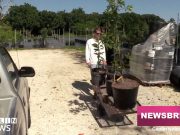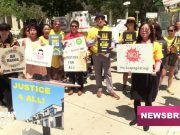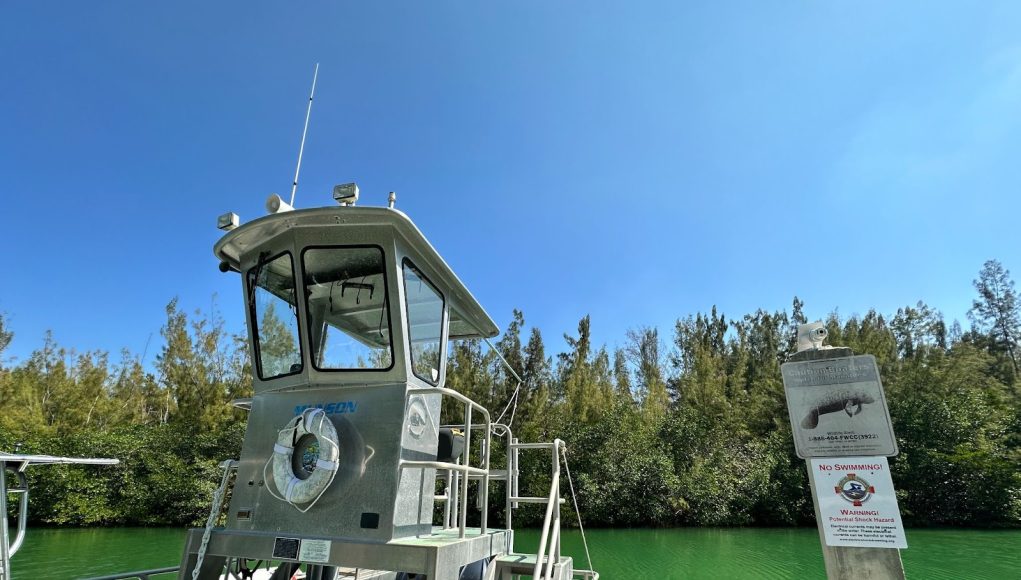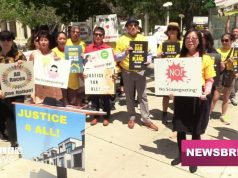In 2011, Rachel Streitfeld realized her home was sinking. As she laced up her rollerblades and put on her helmet for a day-long exploration of South Beach, she was met with an unexpected sight: West Avenue, one of Miami Beach’s busiest and most affluent neighborhoods, was under a foot of water.
“I thought: wow, what’s going on?” said Streitfeld. “That’s when I started reading about sea level rise and getting more into environmental causes. That’s when I realized we needed to adapt.”
Streitfeld would set herself on a path that ultimately led her to study environmental law and become a commissioner of North Bay Village, spearheading the fight for climate resilience in South Florida.
“We can’t stop the water from coming,” she said. “But we can make sure our elected officials are prioritizing the infrastructure projects people need.”
The waters threatening Streitfeld’s little village are coming from Biscayne Bay, a shallow lagoon that stretches from Miami downtown to the Turkey Point nuclear plant. The estuary is home to a rich diversity of marine life, from manatees and dolphins to seagrass and coral. It is also a vital source of recreation, tourism, and economic activity for millions of residents and visitors. But this natural treasure is in peril.
The bay chokes on the filth of the city. The water pumps that keep Miami-Dade from sinking and help it fight the effects of climate change are one of the main sources of pollution in Biscayne Bay. They flush stormwater runoff from the streets into the bay, carrying dirt, debris, oil, pesticides, and trash.
“The canals and the pumps empty into our coast, and the South Florida Water Management District doesn’t really have a way to polish the water before it gets there,” said Streitfeld. ” It becomes this vicious cycle where the pollutants cause the seagrass at the bay to further die off, which then causes the bay to be even less oxygenated, which destroys the capability of the ecosystem to heal.”
For a full graph, click this interactive map.
One of the main pollutants is human and animal fecal matter, which, besides the health and environmental risks they have on their own, also contain large quantities of nitrogen and phosphorus that feed excessive algae and bacteria growth, killing other organisms and consuming most of the water oxygen.
“There are more than 100,000 homes near Biscayne Bay that still use outdated septic tanks,” said Dr. Todd Crowl, director of FIU’s Institute of Environment and one of the most respected researchers of Biscayne Bay. “We have to convert from septic to sewer, and we have to upgrade our stormwater drains because otherwise, this will keep happening.”
Miami’s water management system constantly suffers breaks and overflows that exacerbate the problem. On March 1, 2023, Miami-Dade issued a no-swim advisory after 2,800 gallons of wastewater accumulated in Biscayne Bay due to a broken pipe.
“We also have other disruptors like all these pharmaceuticals that people take,” said Dr. Crowl. “People go to the bathroom and that water ends in the sewer, which then gets into the bay. we’re starting to see some accumulation of those metals and endocrine disruptors not only in the bay but also in the blood of fish and other animals there.”
In 2021, scientists from the FIU Institute of Environment also found large quantities of 30 different types of PFAS or “forever chemicals” in Biscayne Bay and nearby tributary canals. These chemicals are widely used in consumer products such as nonstick cookware, stain-resistant fabrics, and firefighting foam. They can accumulate in living organisms and cause health problems such as cancer, hormone disruption, and immune system damage.
“We don’t want to cause alarm or freak people out,” FIU chemistry Assistant Professor Natalia Soares Quinete said. “Our goal is to provide the much-needed data on the current state of our water so that people are aware of these contaminants and know where they are coming from.”
Finally, to make matters worse, the Miami New Times reported in 2016 that the levels of tritium in the bay were 200 times the normal amount. Tritium, which is a cancerous radioactive isotope that emits a bright green light, is usually used in nuclear energy production. That same year, a judge found that the nuclear plant of Turkey Point had failed to prevent hundreds of thousands of gallons of wastewater from seeping into the bay.
“These are serious and complex problems, most of which will require lots of money and a community-wide approach to restoration and recovery,” said Irela M. Bagué in a press release for the Greater Miami Chamber of Commerce. Bagué is the chair of the Miami-Dade County Biscayne Bay Task Force. “Our environment is our economy.”
The pollution is killing the local flora and driving off fish. In August 2020, a massive fish kill occurred in the northern part of the bay, where thousands of dead fish floated on the surface.
“I will never forget seeing fish literally coming up gasping for air because there was no oxygen in the bay for them to breathe,” said Streitfeld. “Since then, we’ve also seen the numbers of manatee deaths increase in the last couple of years.”
The fish kill was a wake-up call for many local officials and environmentalists who have been sounding the alarm for years about the declining state of the bay. They have called for urgent action to restore water quality, reduce nutrient loads, enforce regulations and increase public awareness.
“The fishkill was the moment that really made me pay more attention to the bay,” said Dr. CrowI. “Before that, I was studying small tropical areas in Puerto Rico, but when I heard that the water oxygen dropped to 0 in Biscayne Bay, I realized this was really serious.”
Since then, Dr. Crowl has made it his life mission to restore the bay. As someone who saw the Cuyahoga River catch fire as a child growing up in 1969 Cleveland, Ohio, he is very aware of the dangers of not prioritizing ecological efforts. He still remembers the shock and horror of witnessing a river burn with flames that reach up to five stories high after the urea and oil contamination was such that it caused an environmental catastrophe.
“However, I know things can improve,” said Dr. Crowl. “During my lifetime, I saw the river on fire, but I also had the opportunity of being able to completely reverse that and clean up the Cuyahoga. We now have all these large fish swimming around and people can go and enjoy the water. So I know that if everybody puts their mind to it, we can fix this.”
Miami-Dade and other local municipalities are planning to counter some of the pollution by installing improved water pumps across the coast in a 10-year plan the city unveiled after receiving federal funds to fight climate change. These pumps are designed to help clean the water before it ends up in Biscayne Bay. However, experts say measures like this are not costly but also insufficient.
“I have been working with the commission and I know this is basically just a membrane that will capture most of the large residuals. It’s not going to take out the chemicals, the bacteria, the excessive nutrients, and so on. That’s not a solution, especially as climate change makes us most reliant on these pumps.” said Dr. Crowl.” What we need is to get rid of all the septic tanks, upgrade all of our sewer pipes, and red-direct most of the storm systems and canals to a facility where the water can be treated before entering the bay.”
Yet, these changes are not cheap, and many of the proposed solutions intersect with already existent racial and income inequalities in Miami-Dade. According to Dr. Crowl, building such a facility would cost billions and replacing septic tanks costs an average of $6,000 per household.
“If I go to Little Haiti, there is no way people can do $6,000 on the spot. So we’ve got sort of social justice issue here,” he said. “And even with those who can, it takes time to find that kind of money and convince everybody.”
As solutions are being debated, the fate of Biscayne Bay hangs in the balance. If nothing significant is done soon to reverse its degradation, it may become an ecological wasteland devoid of life and beauty —an environmental crisis in stark contrast with the multi-million dollar condos bordering the bay.
“The problem with tipping points is that they really are not a linear projection,” said Dr. Crowl. “Our current prediction is less than 10 years before the bay becomes an entirely different ecosystem. But I don’t know how much faster it’s going to get. We’re really racing against the clock.”

































